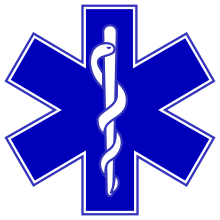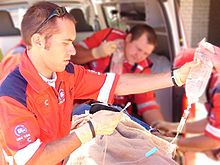Paramedic
Paramedic is a term used in English by non-medical professional groups in the rescue service . Paramedics are often used around the world in rescue and emergency medical systems that are not supported by a doctor.
Paramedics in the US

education
The training and skills differ depending on the local conditions.
Training to become an EMT-P (Emergency Medical Technician - Paramedic) takes between two and four years. The training is divided into the basic training for EMT-B (Emergency Medical Technician - Basic), the advanced training for EMT-I (Emergency Medical Technician - Intermediate) and the final training. EMT-Ps have often graduated from college with an Associate Degree as Associate of Applied Sciences - Paramedic .
Contents of the EMT-B training
- Immediate life-saving measures and first aid
- Oxygen supply
- Use of the spineboard
- Splints from broken bones
Contents of the EMT-I training
- Intravenous access
- Intubation
- Initial medication for cardiovascular problems
Contents of the EMT-P training
- Interpretation of the EKG
- Drug administration
- Extended airway security (e.g. Rapid Sequence Induction )
- Resuscitation of multiple trauma patients
- Child emergencies
The core competencies are ACLS (Advanced Cardiac Life Support) and analgesia for making people fit for transport.
Voluntary certification
In the USA there is a certification of EMTs (paramedics or paramedics) according to the level of training on four levels. Even if individual states have different rules, the minimum standards of the US Department of Transportation - standards for the EMT-B (Emergency Medical Technician - Basic) curriculum must be met.
The voluntary registration procedure distinguishes between:
- EMT-Basic (corresponds roughly to the paramedic in Germany)
- EMT-I / 85 (Intermediate) (e.g. the paramedic in Germany)
- EMT Paramedic (such as the paramedic and the paramedic )
Working method
Paramedics are strongly tied to fixed procedures according to which they have to act. In the USA , the paramedics have usually given a list of standard measures that they are allowed to take. These lists are issued by the respective state and vary by state, educational level and situation. It can also be provided that a doctor must agree to the measure by radio, with behavior for radio failures also being provided.
Popular culture
The television series Emergency! (German Notruf California ) illustrated its work in a popular way during the emergence of the Paramedic system in the early 1970s.
Paramedics in Canada
education
There are three types of paramedics in Canada:
- Primary Care Paramedic
- Advanced Care Paramedic
- Critical Care Paramedic
Primary Care Paramedicine training takes one to two years. After one to three years of professional experience, you can be trained as an Advanced Care Paramedic in two to three semesters. After further practical experience and two to three semesters of training, you become a Critical Care Paramedic.
Contents of the primary care paramedic training
- Immediate life-saving measures and first aid
- Administration of medication to combat symptoms (oxygen, nitroglycerin, ASA, adrenaline, etc.)
- Use of the spineboard
- Semi-automatic defibrillation
Contents of the advanced care paramedic training
- peripheral venous access
- Intubation
- Medication administration (20 medications)
- Tension pneumothorax relief
- Interpretation of the EKG
- Defibrillation
Contents of the critical care paramedic training
- Medication administration (60 medications)
- Extended airway security (e.g. Rapid Sequence Induction )
Working method
The training is very intensive and therefore paramedics in Canada are equated with nursing and other non-medical training. With the permission of a doctor, they may also carry out measures that are part of the standard catalog of higher education.
The critical care paramedics are mostly only used for intensive care transports.
Paramedics in the UK
education
University degree according to the standards of the Colleges of Paramedics at a recognized university, examples: BSc (Hons), four years or FdSc Paramedic Science, three years and other postgraduate courses. All other requirements do not apply and are either partly regulated by student internships, by the College of Paramedics or by the employer. Recertification takes place through the College of Paramedics.
Other emergency services training in the UK includes the following courses.
- Ambulanceman:
- 96 hours of basic training
- Emergency Medical Technician (EMT) (see paramedic ):
- One-year service as an ambulance man is required
- 360 hours of training
- Emergency Care Assistant (ECA):
This training is so far only slightly regulated and is intended to replace the two above-mentioned training levels. The job description is laid out as an assistant to paramedics. The ECA does not have its own treatment competencies.
It is no longer possible to advance to paramedic through practice and training from the Ambulance Technician or Emergency Medical Technician.

